Fueling the Fire by FreeWee Ling
With open art competitions, anyone can enter just about anything. So we get a wide variety, from noobs to seasoned pros. We never know what’s going to come in. And it’s not always the superstars who win the competitions. Some shows are stronger than others. Yet there’s always enough real quality to serve as a foundation.
Artists are the ones who push the technology. It’s remarkably easy to be expressive here—dramatically so. Just look at Chuckmatrix’s work using normal prims—it blows me away.
We’re often surprised at what wins. And in fact, when I’m surprised, it makes me examine the work that much more closely to figure out what people saw that I didn’t.
Also, I am fortunate that I can award a Curator’s Prize, which lets me sometimes correct what I perceive as an injustice. Because I’m able to spend a lot of time with all the work, I often see things that are not obvious to people who just visit. I spend more time with this work than anyone. After a while, I might see something really amazing that I hadn’t noticed before.
Spending so much time in intimate contact with the work and with the artists is my favorite part of the job. I help them present their work in the best possible way. There’s so much depth if you can spend the time. Cataloging, documenting, arranging—these are my benefits. I make a list of points about each piece I think needs to be noted. The exhibition catalogs online are official UWA periodicals, registered ISSN, etc.
Most work that I see is derivative. including my own. It’s the original way you treat an old idea that makes it new. It’s the novelty that makes it art.
What may be flashy and cool to an outsider might use prefab mesh parts or standard freebie animations. Some things are not special if you’ve been in SL for a while. If I can’t figure out how something was done, then I’m impressed! Often I ask the artist to find out because I don’t like magic; I want to know how things work.
The Artists’ Choice theme shows have been smaller than the open competitions. I have done these shows on my own—found sponsors and produced, etc.—though I am not good at all that organization. The big money shows, like REFLECTIONS, are UWA official exhibitions. We have a reputation, that people want to be associated with. I’m very pleased with the entry numbers, and, most especially, with the quality.
Artists often don’t like to be confined by a theme, though kept intentionally vague to allow the broadest possible interpretations. For example, in the Fire show, one artist displayed a single flexible prim—a pink slip—a notice of being fired. Completely unexpected! With Reflections’ interpretations, I am surprised how many are literal versus conceptual. Misprint Thursday and Takni Miklos used the water mirror effect in really engaging ways [see Ele’s blog for her interaction with Mistrpint’s entry winner from the “Reflections” show].
Many don’t believe in competitions for art. It’s kind of absurd to be judging this piece against that. But it does generate a lot of good new work. Most artists say they don’t think about the competitions; they just want to have their work seen in a prestigious venue.
Some of the judges, top people in the arts, are not in SL. They don’t know who is who.and they judge out of context. So there are often surprises. Part of my mission is to educate them. The head of the arts precinct at UWA is a strong supporter. He’s also chair of visual arts on the Australia national arts commission.
These shows need a lot of behind the scenes management. I work with the artists on installation, document, and so on. It’s not so hard here—not like having to hang a real life show.
There is a wide range of thinking about whether this work is valuable since it is so ephemeral and limited to this technology.
Time is the most challenging part of my work in SL. I have too many interests—sort of an ADD thing. My time at UWA varies according to the show cycles.Then I work here on a dozen different projects at once.
I don’t have a degree in art. I’m a musicologist. But I grew up in Chicago, practically living in the Art Institute. Even my academic studies in music always relate to art. I probably know art history better than most people who are not specialists.
My personal interests are about musical instruments as cultural and artistic objects. I’ve made some replicas in SL—like the pipe organ in Withrop Hall at UWA. In real life, as an amateur, I perform with an early music group—medieval through baroque.
Also in real life, my university job in the US was recently eliminated. So I spend a lot of time looking for work, It also means I spend more time here. When I was working full time, I still managed to spend 40-60 hours a week in SL. I have no social life. Much of my time is involved in art. But I do find time to explore once in a while—amazed at how much I don’t know.
SL is overwhelming to most people at first. It was to me. I got into art here because I need to associate with those doing creative work, with a positive attitude. There’s too much drama and weirdness out there. But also so much amazing creative energy!
I first heard of SL around 2006, from a story on NPR. I’d been interested in technology and VR for a long time, waiting for something like this to happen. I knew it was coming. When I found it, it was like coming home!
Although I have been with UWA for nearly three years, I owned a sim for about five. There I had a gallery where I hired curators to run it on a day to day basis. I closely supervised them, built the gallery building, did publicity, etc. We had some great shows. It was a lot of work, though. Eventually I gave up the sim because it cost too much. Though renters covered some of the costs, I paid nearly half out of my own pocket. I was never good at recruiting new residents and never liked the business aspects.
Running a gallery comes down to looking at art carefully—really looking at it and understanding it. With my sim, I tried to get people to live with the art, to spend time with it day-to-day. Living with art is qualitatively different from visiting it.
When I was associated with the Caerleon group (a series of grant-funded sim-wide shows by teams of SL artists), I found the competitions at UWA. There were monthly open challenges then. I won two, and got honorable mention.
The secret of our successful collaboration is that JayJay is an unflappably positive person. His first response to anything anyone wants to do is ‘Yes.’
So I would come by UWA and talk with JayJay about art. He has no real background, but he has a good eye. I gave him my unvarnished opinions on the work. I think he learned something, but he knows more than he lets on. His job at UWA is manager of the School of Physics. He established UWA in SL as a project for that department. But when he got funded, the head of the art precinct asked if he could do something with art, and JayJay said ‘sure.’
He is been brilliant at getting UWA to support the programs here. There’s really not that much direct benefit to the university. But he’s established it as a preeminent presenter of virtual art. He gives talks all over the world. Having a prestigious arts program brings good attention to the university.
When Jayjay needed an assistant, he invited me to work at UWA. Much in place when I started. I also work on the virtual campus, currently on a recreation of their Anatomy, Physiology, and Human Biology complex. They’re planning to hold anatomy classes in-world.
Today, more of my “real” work is in SL—keeping up with developments in technologies and how they impact lives and creativity. Being associated with some of the great names in SL art is humbling. More than an artist myself, I am an experimenter. I think of my workspace as laboratory rather than as a gallery.
You can create a high level of work, as always, using traditional prim building, but if you compare work here to what can be produced in 3D modeling software, there’s no comparison. This is not the point of making art in SL.
SL is incomparably compelling. You can project your consciousness into a digital body—make it virtually corporeal—and interact with others and with objects. I can be here, in real time, with people from all over the world, and talk to them as though in the same room. Having the digital body is a qualitatively different experience from video chat or some other 2D technology. The projection of identity into a virtual world is a potentially life-changing experience.
It doesn’t have anything to do with other media. I don’t come here to watch video on a prim or read a book in notecard form. There are better places for that. But for individuals interacting with each other, this technology is uniquely engaging.
The people and programs that are successful here exploit its unique features. It’s hard to explain to people who haven’t experienced it. Outsiders often think it’s a game, but if they talk to some of the disabled people about the next show— The Freedom Project—I think they’ll better understand. Taking entries from now until February, this unique show is in partnership with several real life organizations that deal with those having chronic illness or disabilities. This show will be a creative opportunity for those people to tell the story of how SL has helped them to overcome their real life obstacles.
—FreeWee Ling, University of Western Australia
– – – – – – – – – – – – – – – – – – – – – – – – – – – – – – – – – – – – – – – – – – – – – – – – – – – – – – – – – – – – – – – – – – – – – – –
Published monthly in complimentary versions: in-world and online.
(Please see the in-world release or download Sim Street Journal #5 for more photographs, articles, and functionality. Also available on MARKETPLACE).
PLEASE SEE SPONSORS FOR SIM STREET JOURNAL ISSUE #5
Contributions are encouraged if covering topics relevant to the real world readers.
Comments and opinions are also encouraged.
– – – – – – – – – – – – – CONTACTS:
Sim Street Journal explores the relevance of virtual to real commerce and culture.
ONLINE: https://simstreetjournal.wordpress.com/
FACEBOOK: https://www.facebook.com/simstreetjournal
IN-WORLD: http://maps.secondlife.com/secondlife/Innu/40/36/1650
MARKETPLACE: https://marketplace.secondlife.com/stores/148961
EMAIL: simstreetjournal@gmail.com
The Sim Street Journal explores the relevance of second to first life.
© 2014 by Eleanor Medier, Sim Street Journal. Articles cannot be reprinted without permission.
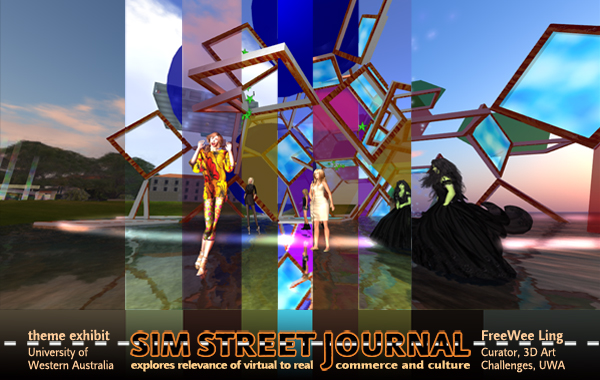
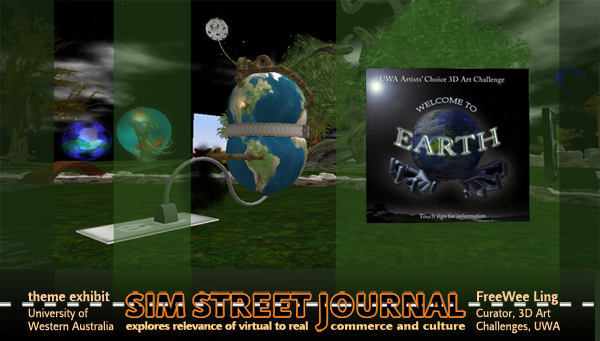
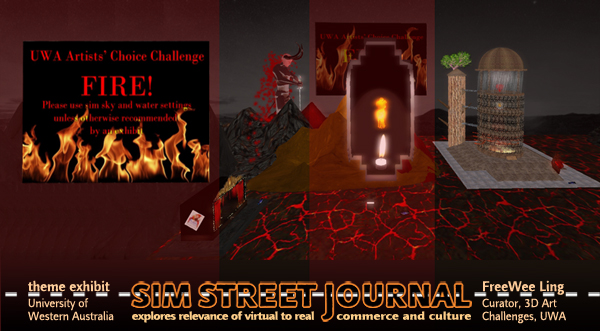
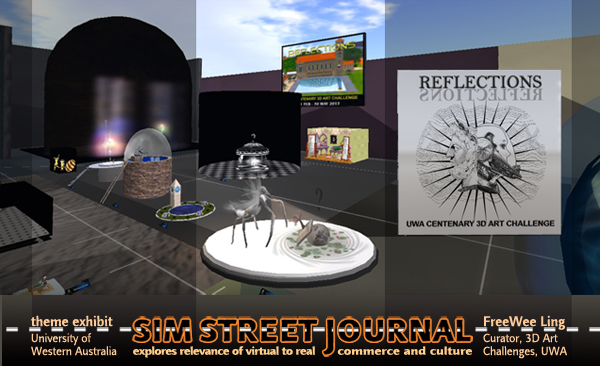
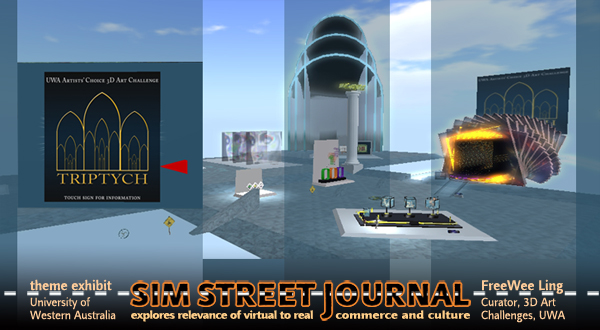
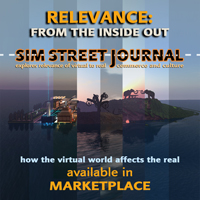
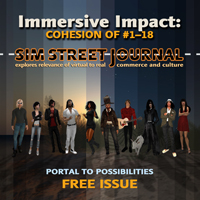
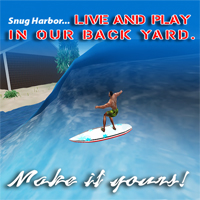

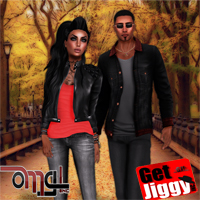


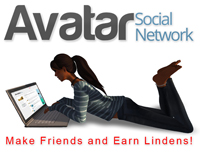
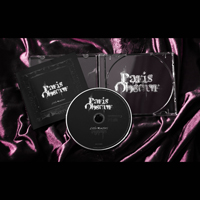
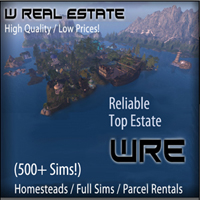
Pingback: Champions of Expression | Sim Street Journal